Unit 8 How do you make a banana milk shake Section A 重要知识考点+练习过关 (含答案)
文档属性
| 名称 | Unit 8 How do you make a banana milk shake Section A 重要知识考点+练习过关 (含答案) | 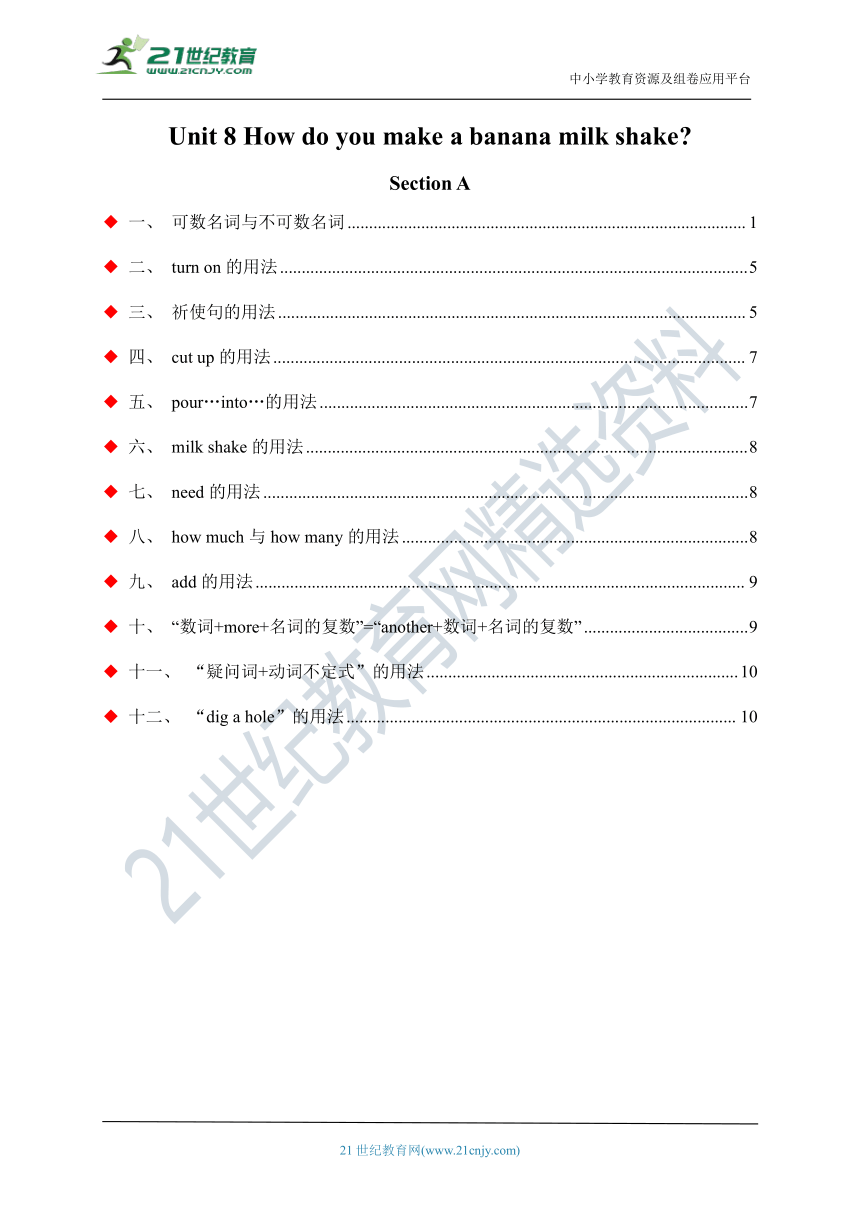 | |
| 格式 | docx | ||
| 文件大小 | 1017.1KB | ||
| 资源类型 | 试卷 | ||
| 版本资源 | 人教新目标(Go for it)版 | ||
| 科目 | 英语 | ||
| 更新时间 | 2021-09-28 07:10:44 | ||
图片预览

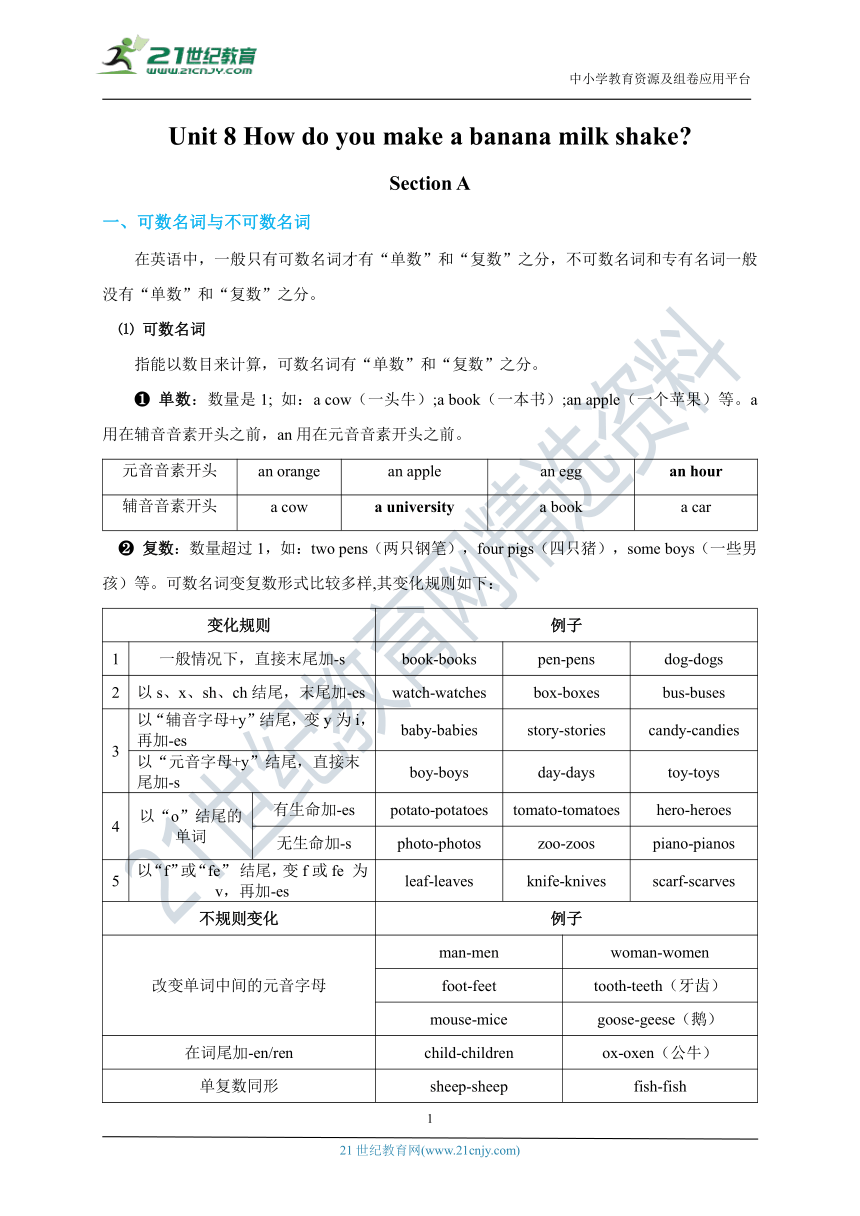
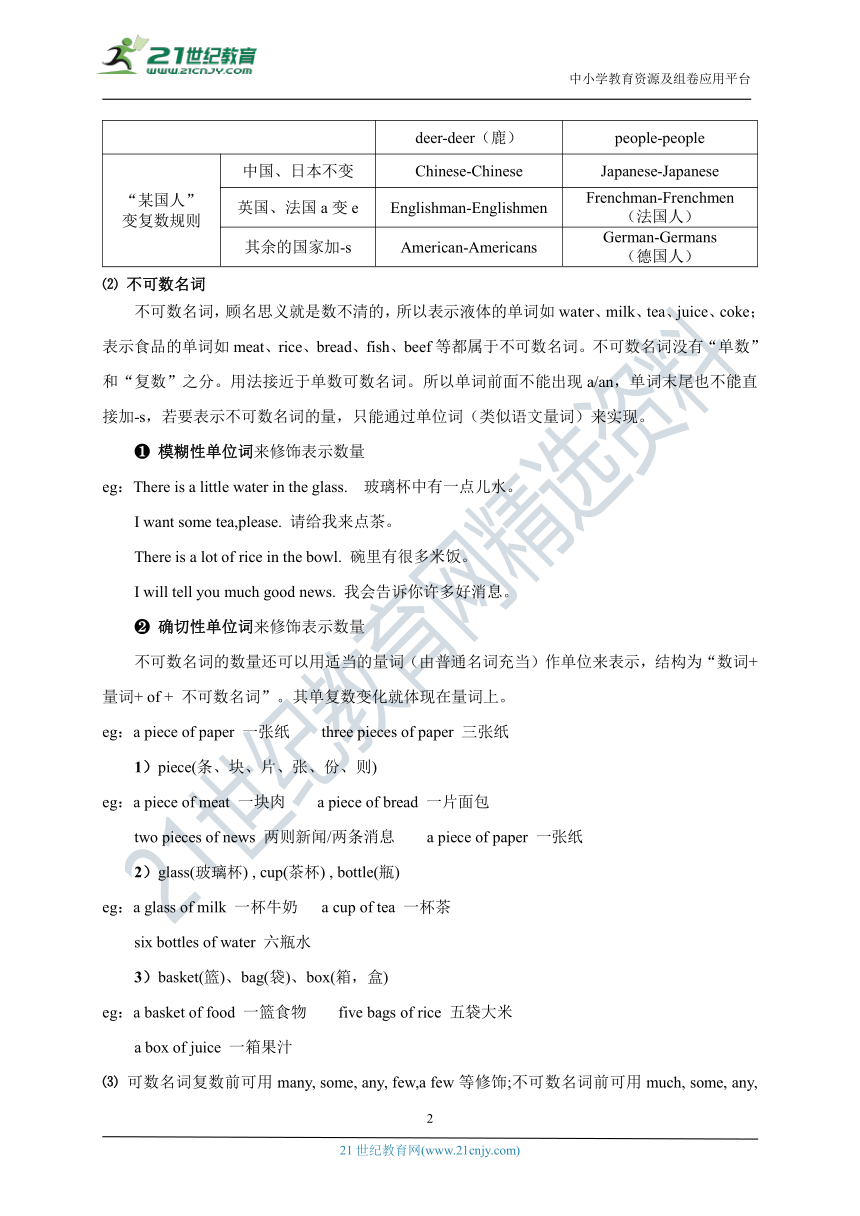
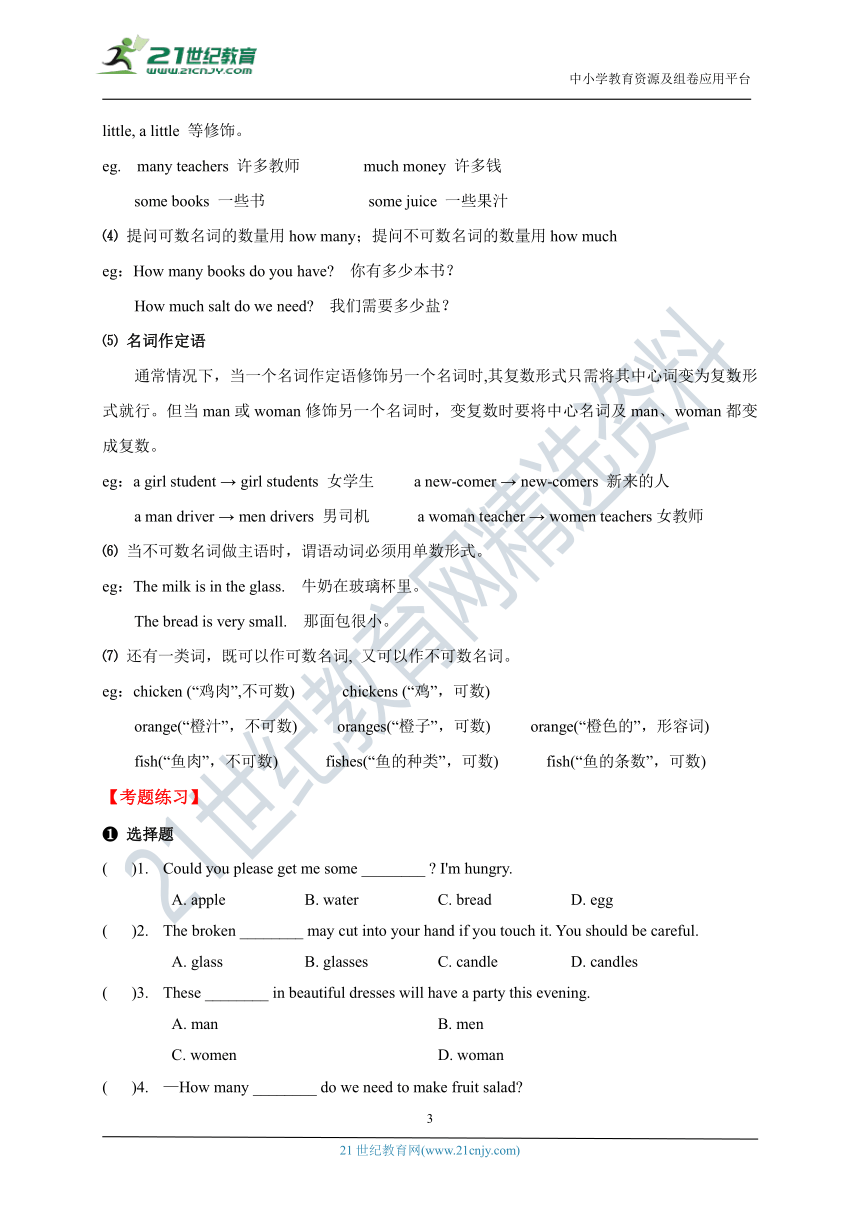
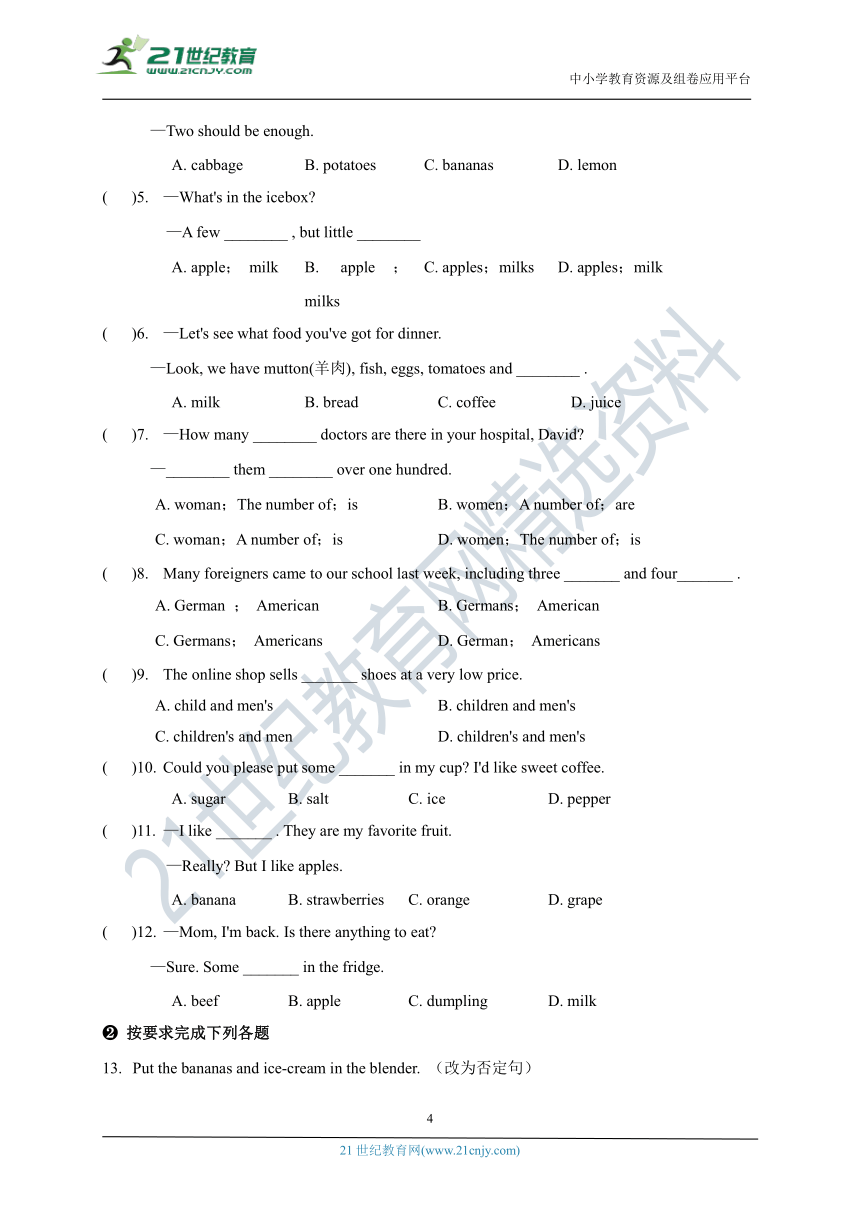
文档简介
Unit
8
How
do
you
make
a
banana
milk
shake?
Section
A
一、
可数名词与不可数名词
1
二、
turn
on的用法
5
三、
祈使句的用法
5
四、
cut
up的用法
7
五、
pour…into…的用法
7
六、
milk
shake的用法
8
七、
need的用法
8
八、
how
much与how
many的用法
8
九、
add的用法
9
十、
“数词+more+名词的复数”=“another+数词+名词的复数”
9
十一、
“疑问词+动词不定式”的用法
10
十二、
“dig
a
hole”的用法
10
中小学教育资源及组卷应用平台
21世纪教育网
www.21cnjy.com
精品试卷·第
2
页
(共
2
页)
21世纪教育网(www.21cnjy.com)
Unit
8
How
do
you
make
a
banana
milk
shake?
Section
A
可数名词与不可数名词
在英语中,一般只有可数名词才有“单数”和“复数”之分,不可数名词和专有名词一般没有“单数”和“复数”之分。
⑴
可数名词
指能以数目来计算,可数名词有“单数”和“复数”之分。
?
单数:数量是1;
如:a
cow(一头牛);a
book(一本书);an
apple(一个苹果)等。a用在辅音音素开头之前,an用在元音音素开头之前。
元音音素开头
an
orange
an
apple
an
egg
an
hour
辅音音素开头
a
cow
a
university
a
book
a
car
?
复数:数量超过1,如:two
pens(两只钢笔),four
pigs(四只猪),some
boys(一些男孩)等。可数名词变复数形式比较多样,其变化规则如下:
变化规则
例子
1
一般情况下,直接末尾加-s
book-books
pen-pens
dog-dogs
2
以s、x、sh、ch结尾,末尾加-es
watch-watches
box-boxes
bus-buses
3
以“辅音字母+y”结尾,变y为i,再加-es
baby-babies
story-stories
candy-candies
以“元音字母+y”结尾,直接末尾加-s
boy-boys
day-days
toy-toys
4
以“o”结尾的单词
有生命加-es
potato-potatoes
tomato-tomatoes
hero-heroes
无生命加-s
photo-photos
zoo-zoos
piano-pianos
5
以“f”或“fe”
结尾,变f或fe
为v,再加-es
leaf-leaves
knife-knives
scarf-scarves
不规则变化
例子
改变单词中间的元音字母
man-men
woman-women
foot-feet
tooth-teeth(牙齿)
mouse-mice
goose-geese(鹅)
在词尾加-en/ren
child-children
ox-oxen(公牛)
单复数同形
sheep-sheep
fish-fish
deer-deer(鹿)
people-people
“某国人”
变复数规则
中国、日本不变
Chinese-Chinese
Japanese-Japanese
英国、法国a变e
Englishman-Englishmen
Frenchman-Frenchmen
(法国人)
其余的国家加-s
American-Americans
German-Germans
(德国人)
⑵
不可数名词
不可数名词,顾名思义就是数不清的,所以表示液体的单词如water、milk、tea、juice、coke;表示食品的单词如meat、rice、bread、fish、beef等都属于不可数名词。不可数名词没有“单数”和“复数”之分。用法接近于单数可数名词。所以单词前面不能出现a/an,单词末尾也不能直接加-s,若要表示不可数名词的量,只能通过单位词(类似语文量词)来实现。
?
模糊性单位词来修饰表示数量
eg:There
is
a
little
water
in
the
glass.
玻璃杯中有一点儿水。
I
want
some
tea,please.
请给我来点茶。
There
is
a
lot
of
rice
in
the
bowl.
碗里有很多米饭。
I
will
tell
you
much
good
news.
我会告诉你许多好消息。
?
确切性单位词来修饰表示数量
不可数名词的数量还可以用适当的量词(由普通名词充当)作单位来表示,结构为“数词+量词+
of
+
不可数名词”。其单复数变化就体现在量词上。
eg:a
piece
of
paper
一张纸
three
pieces
of
paper
三张纸
1)piece(条、块、片、张、份、则)
eg:a
piece
of
meat
一块肉
a
piece
of
bread
一片面包
two
pieces
of
news
两则新闻/两条消息
a
piece
of
paper
一张纸
2)glass(玻璃杯)
,
cup(茶杯)
,
bottle(瓶)
eg:a
glass
of
milk
一杯牛奶
a
cup
of
tea
一杯茶
six
bottles
of
water
六瓶水
3)basket(篮)、bag(袋)、box(箱,盒)
eg:a
basket
of
food
一篮食物
five
bags
of
rice
五袋大米???
a
box
of
juice
一箱果汁
⑶
可数名词复数前可用many,
some,
any,
few,a
few等修饰;不可数名词前可用much,
some,
any,
little,
a
little
等修饰。
eg.
many
teachers
许多教师
much
money
许多钱
some
books
一些书
some
juice
一些果汁
⑷
提问可数名词的数量用how
many;提问不可数名词的数量用how
much
eg:How
many
books
do
you
have?
你有多少本书?
How
much
salt
do
we
need?
我们需要多少盐?
⑸
名词作定语
通常情况下,当一个名词作定语修饰另一个名词时,其复数形式只需将其中心词变为复数形式就行。但当man或woman修饰另一个名词时,变复数时要将中心名词及man、woman都变成复数。
eg:a
girl
student
→
girl
students
女学生
a
new-comer
→
new-comers
新来的人
a
man
driver
→
men
drivers
男司机
a
woman
teacher
→
women
teachers女教师
⑹
当不可数名词做主语时,谓语动词必须用单数形式。
eg:The
milk
is
in
the
glass.
牛奶在玻璃杯里。
The
bread
is
very
small.
那面包很小。
⑺
还有一类词,既可以作可数名词,
又可以作不可数名词。
eg:chicken
(“鸡肉”,不可数)
chickens
(“鸡”,可数)
orange(“橙汁”,不可数)
oranges(“橙子”,可数)
orange(“橙色的”,形容词)
fish(“鱼肉”,不可数)
fishes(“鱼的种类”,可数)
fish(“鱼的条数”,可数)
【考题练习】
?
选择题
Could
you
please
get
me
some
________
?
I'm
hungry.
A.
apple
B.
water
C.
bread
D.
egg
The
broken
________
may
cut
into
your
hand
if
you
touch
it.
You
should
be
careful.
A.
glass
B.
glasses
C.
candle
D.
candles
These
________
in
beautiful
dresses
will
have
a
party
this
evening.
A.
man
B.
men
C.
women
D.
woman
—How
many
________
do
we
need
to
make
fruit
salad?
—Two
should
be
enough.
A.
cabbage
B.
potatoes
C.
bananas
D.
lemon
—What's
in
the
icebox?
—A
few
________
,
but
little
________
A.
apple;
milk
B.
apple;
milks
C.
apples;milks
D.
apples;milk
—Let's
see
what
food
you've
got
for
dinner.
—Look,
we
have
mutton(羊肉),
fish,
eggs,
tomatoes
and
________
.
A.
milk
B.
bread
C.
coffee
D.
juice
—How
many
________
doctors
are
there
in
your
hospital,
David?
—________
them
________
over
one
hundred.
A.
woman;The
number
of;is
B.
women;A
number
of;are
C.
woman;A
number
of;is
D.
women;The
number
of;is
Many
foreigners
came
to
our
school
last
week,
including
three
_______
and
four_______
.
A.
German
;
American
B.
Germans;
American
C.
Germans;
Americans
D.
German;
Americans
The
online
shop
sells
_______
shoes
at
a
very
low
price.
A.
child
and
men's
B.
children
and
men's
C.
children's
and
men
D.
children's
and
men's
Could
you
please
put
some
_______
in
my
cup?
I'd
like
sweet
coffee.
A.
sugar
B.
salt
C.
ice
D.
pepper
—I
like
_______
.
They
are
my
favorite
fruit.
—Really?
But
I
like
apples.
A.
banana
B.
strawberries
C.
orange
D.
grape
—Mom,
I'm
back.
Is
there
anything
to
eat?
—Sure.
Some
_______
in
the
fridge.
A.
beef
B.
apple
C.
dumpling
D.
milk
?
按要求完成下列各题
Put
the
bananas
and
ice-cream
in
the
blender.
(改为否定句)
______________________________________________________________________________
I
want
to
know
how
I
can
plant
a
tree.(改为同义句)
_____________________________________________________________________________
We
need
three
spoons
of
yogurt
to
make
the
milk
shake.(对划线部分提问)
_____________________________________________________________________________
He
cooked
them
for
5
minutes.(对画线部分提问)
______________________________________________________________________________
The
baby
drinks
a
cup
of
milk
every
morning.
(对画线部分提问)
______________________________________________________________________________
turn
on的用法
turn
on意为“打开;接通(电流;煤气;水等)”,其反义短语为turn
off意为“关闭;切断(电流;煤气;水等)”。
★
与turn相关的短语:
turn
on
turn
off
turn
up
turn
down
打开
关闭
凋高(音量等)
凋低(音量等)
★
turn
on
与
open的区别
turn
on
打开;接通(电源等)
通常指打开水龙头、电灯、电视等电器的开关,其对应短语是turn
off。
open
打开;敞开
通常指把关着或封着的门、窗、箱子、盒子等打开,其对应词是close。
【考题练习】
请打开收音机。
Please
_________
_________
the
radio.
不要忘记关灯。
Don't
forget
to
_________
_________
the
light.
打开门,并打开所有的灯。
_________
the
door
and
_________
_________
all
the
lights.
祈使句的用法
祈使句通常以动词原形开头,用于表达命令、请求、劝告、警告和禁止等的句子称为祈使句。否定式在动词原形前面加don't。其主语是第二人称,所以通常省略主语,句末使用感叹号或者句号。
eg:Turn
on
the
blender.
打开食物搅拌器
(命令)
Go
and
wash
your
hands!快去洗手!(命令)
Be
quite,
please!
请安静!(请求)
Be
kind
to
the
children.善待孩子们。(劝告)
Watch
your
steps!小心脚下!(警告)
No
photos!禁止拍照!
No
Smoking!禁止吸烟!(禁止)
◆
祈使句的类型及用法
肯定结构:
类型
例子
DO型:动词原形+(宾语)+其他
Please
write
down
your
name.请写下你的名字。
Open
the
window,please.请打开窗户。
Be型:Be+表语+其他成分
Be
a
good
girl!做一个好孩子!
Be
quick!快一点!
Let型:Let+宾语+动词原形+其他
Let
me
help
you!我来帮你吧!
Let's
clean
the
classroom!(Let's=Let
us)
让我们来打扫教室!
否定结构:
类型
例子
DO型:Don't+动词原形+(宾语)+其他
Please
don't
write
down
your
name.
请不要写下你的名字。
Don't
open
the
window,please.
请不要打开窗户。
Be型:Don't+Be+表语+其他成分
Don't
be
a
good
girl!别做个好女孩!
Don't
be
quick!别这么快!
Let型:
Don't+Let+宾语+动词原形+其他
Don't
Let
me
help
you!别让我帮你!
Let's
not
clean
the
classroom!
我们不打扫教室!
Let+宾语+not+动词原形+(其他)。
【考题练习】
Don't
_____________(arrive)
late
for
Lucy's
birthday
party.
Please
_____________(listen)
carefully
to
what
the
teacher
says.
Don't
_____________(swim)
in
the
river.
It's
too
dangerous.
You
must
___________(make)
the
bed
after
you
get
up.
She
has
to
___________(be)
quiet
in
the
library.
Let's________
our
family
rules.
A.
get
B.
give
C.
make
D.
go
—________
arrive
late
for
class
again,
Mike.
—Sorry,
I
won't.
A.
Not
B.
Don't
C.
No
D.
Can't
cut
up的用法
cut
up
意为“切碎”,相当于cut……into
pieces,cut
up是一个“动词+副词”型短语,人称代词作宾语时只能放在两词之间;名词作宾语时,可放在两词之间,也可放在up的后面。
◆
与cut相关的短语:
cut
up
cut
down
cut
off
cut
out
cut
in
切碎
砍到;砍伐
切断;切除
删除
插嘴
【考题练习】
请帮我把这些苹果切碎。
Please
help
me
________
________
________
________.
把肉递给我。我要切碎它。
Hand
the
meat
to
me.
I'll
________
________
________.
pour…into…的用法
pour…into…意为“将…倒入…”,into为介词,意为“到…里面;进入”。
eg:Please
pour
the
water
into
the
bowl.
请把水倒入碗中。
?
into意为“到…里面;进入”,是表示动态的介词;in意为“在…内”,是表示静态的介词。
eg:She
is
walking
in
the
room.
她正在房间里走来走去。
?
在put,
throw,
break,
fall等动词之后,既可以用in,也可以用into,这时in也表示动态,常含有into的意思。
eg:He
put
all
the
books
in/into
the
bag.
他把所有的书都放进了包里。
?
in可以用作副词,into则不能。
eg:Come
in!进来!
【考题练习】
请把水倒入碗中。
Please
________
the
water
________
the
bowl.
她走进了房间。
She
walked
________
the
room.
milk
shake的用法
milk
shake意为“奶昔”,此处shake作名词,意为“奶昔”,是一种用牛奶、冰激凌和水果或巧克力做成的饮料。
◆
shake还可用作动词,意为“摇动;抖动”。其过去式为shook。
eg:The
house
shook
when
the
earthquake
started.
地震开始时房子摇晃起来。
【考题练习】
你怎样做香蕉奶昔?
How
do
you
make
a
________
________
________?
第一次见面时我们通常握手。
We
usually
________
________
when
we
met
for
the
first
time.
need的用法
need用作实义动词,意为“需要”,其后可接名词、代词或动词不定式作宾语。
need作情态动词,意为“需要”,一般用于否定句或疑问句中,后面必须接动词原形。
【考题练习】
我们需要多少香蕉?
________
________
________
do
we
________
?
她需要试一下。
She
________
________
________
a
try.
你今天不必完成那项工作。
You
________
________
that
work
today.
how
much与how
many的用法
how
much
多少
提问数量,后接不可数名词。
多少钱
提问价格
how
many
多少
提问数量,后接可数名词复数。
【考题练习】
—________
________
water
do
you
want?
—Two
bottles.
—________
________
are
your
shoes?
—90
yuan.
—________
________
books
do
you
have?
—six.
add的用法
add用作及物动词,意为“增加;添加”。add……to……意为“添加……到……”。put……into……
意为“把……放进……里”。
?
add
to意为“增加;增添”。
?
add
up
to意为“总共是;总计为”。
【考题练习】
接下来,把牛肉、胡萝卜和土豆放入锅中,并加一些水。
Next,
_______
the
beef,
carrots
and
potatoes
_______
a
pot
and
_______
_______
_______.
如果你把六加十,你会得到十六。
If
you
________
six
________
ten,
you
will
get
sixteen.
电视增加了我们的快乐。
The
TV
________
________
our
happiness.
所有这些总共是20。
All
of
these
________
________
________
20.
“数词+more+名词的复数”=“another+数词+名词的复数”
都表示表示在原有基础上“又,再,额外”;一般而言,“another+数词+名词的复数”不带有感彩,是中立的,陈述另外还有几个。而“数词+more+名词的复数”指的是还要几个。
another
20
minutes意为“另外20分钟”。“another
+基数词+名词”表示“又…
再…”,相当于“基数词+
more+名词”表示“又…
再…”
【考题练习】
然后,加入卷心菜、西红柿和洋葱,再煮10分钟。
Then,
________
the
cabbage,
tomatoes
and
onion
and
cook
for
________
________
________.
The
doctor
worked
for
another
two
hours
after
twelve
o'clock.(改为同义句)
The
doctor
worked
for
________
________
________
after
twelve
o'clock.
“疑问词+动词不定式”的用法
“疑问词+动词不定式”这种结构前面第五章已经讲过,动词不定式前可与疑问词(how/what/when/where/which/whose(+名词))+动词不定式,意为“应该如何做/何时做/何地做/做哪些事…”。在句子里作主语,宾语,表语等,注意why后的不定式不带to
【考题练习】
我不知道接下来做什么.
I
don't
know
________
________
________
next.
你知道怎样种树吗?
Do
you
know
________
________
________
a
tree
?
I
don't
know
what
to
do.
I
don't
know
what
________
________
________.
我没有决定住哪个房间。
I
didn't
decide
which
room
to
________
________.
“dig
a
hole”的用法
dig作及物动词,意为“掘(地);凿(洞);挖(土)”,其过去式是dug,现在分词是digging。hole作可数名词,意为“洞;孔;坑”。
【考题练习】
他们将在冬天来临前把花园翻一遍。
They
________
________
the
garden
before
winter.
他们正在挖什么?
What
are
they
________?
他挖了个洞并种了一棵树。
He
________
a
hole
and
planted
a
tree.
参
考
答
案
C
A
C
C
D
B
D
C
D
A
B
A
Don't
Put
the
bananas
and
ice-cream
in
the
blender.
I
want
to
know
how
to
plant
a
tree.
How
many
spoons
of
yogurt
do
you
need
to
make
the
milk
shake?
How
long
did
he
cook
them?
How
much
milk
does
the
baby
drink
every
morning?
turn
on
turn
off
Open;turn
on
arrive
listen
swim
make
be
C
B
cut
up
the
apples/cut
the
apples
up
cut
it
up
pour;
into
into
banana
milk
shake
shook
hands
How
many
bananas;
need
needs
to
have
needn't
finish
How
much
How
much
How
many
put;into;add
some
water
add;to
adds
to
add
up
to
add;another
10
minutes/10
more
minutes
two
more
hours
what
to
do
how
to
plant
I
should
do
live
in
will
dig
digging
dug
21世纪教育网(www.21cnjy.com)
8
How
do
you
make
a
banana
milk
shake?
Section
A
一、
可数名词与不可数名词
1
二、
turn
on的用法
5
三、
祈使句的用法
5
四、
cut
up的用法
7
五、
pour…into…的用法
7
六、
milk
shake的用法
8
七、
need的用法
8
八、
how
much与how
many的用法
8
九、
add的用法
9
十、
“数词+more+名词的复数”=“another+数词+名词的复数”
9
十一、
“疑问词+动词不定式”的用法
10
十二、
“dig
a
hole”的用法
10
中小学教育资源及组卷应用平台
21世纪教育网
www.21cnjy.com
精品试卷·第
2
页
(共
2
页)
21世纪教育网(www.21cnjy.com)
Unit
8
How
do
you
make
a
banana
milk
shake?
Section
A
可数名词与不可数名词
在英语中,一般只有可数名词才有“单数”和“复数”之分,不可数名词和专有名词一般没有“单数”和“复数”之分。
⑴
可数名词
指能以数目来计算,可数名词有“单数”和“复数”之分。
?
单数:数量是1;
如:a
cow(一头牛);a
book(一本书);an
apple(一个苹果)等。a用在辅音音素开头之前,an用在元音音素开头之前。
元音音素开头
an
orange
an
apple
an
egg
an
hour
辅音音素开头
a
cow
a
university
a
book
a
car
?
复数:数量超过1,如:two
pens(两只钢笔),four
pigs(四只猪),some
boys(一些男孩)等。可数名词变复数形式比较多样,其变化规则如下:
变化规则
例子
1
一般情况下,直接末尾加-s
book-books
pen-pens
dog-dogs
2
以s、x、sh、ch结尾,末尾加-es
watch-watches
box-boxes
bus-buses
3
以“辅音字母+y”结尾,变y为i,再加-es
baby-babies
story-stories
candy-candies
以“元音字母+y”结尾,直接末尾加-s
boy-boys
day-days
toy-toys
4
以“o”结尾的单词
有生命加-es
potato-potatoes
tomato-tomatoes
hero-heroes
无生命加-s
photo-photos
zoo-zoos
piano-pianos
5
以“f”或“fe”
结尾,变f或fe
为v,再加-es
leaf-leaves
knife-knives
scarf-scarves
不规则变化
例子
改变单词中间的元音字母
man-men
woman-women
foot-feet
tooth-teeth(牙齿)
mouse-mice
goose-geese(鹅)
在词尾加-en/ren
child-children
ox-oxen(公牛)
单复数同形
sheep-sheep
fish-fish
deer-deer(鹿)
people-people
“某国人”
变复数规则
中国、日本不变
Chinese-Chinese
Japanese-Japanese
英国、法国a变e
Englishman-Englishmen
Frenchman-Frenchmen
(法国人)
其余的国家加-s
American-Americans
German-Germans
(德国人)
⑵
不可数名词
不可数名词,顾名思义就是数不清的,所以表示液体的单词如water、milk、tea、juice、coke;表示食品的单词如meat、rice、bread、fish、beef等都属于不可数名词。不可数名词没有“单数”和“复数”之分。用法接近于单数可数名词。所以单词前面不能出现a/an,单词末尾也不能直接加-s,若要表示不可数名词的量,只能通过单位词(类似语文量词)来实现。
?
模糊性单位词来修饰表示数量
eg:There
is
a
little
water
in
the
glass.
玻璃杯中有一点儿水。
I
want
some
tea,please.
请给我来点茶。
There
is
a
lot
of
rice
in
the
bowl.
碗里有很多米饭。
I
will
tell
you
much
good
news.
我会告诉你许多好消息。
?
确切性单位词来修饰表示数量
不可数名词的数量还可以用适当的量词(由普通名词充当)作单位来表示,结构为“数词+量词+
of
+
不可数名词”。其单复数变化就体现在量词上。
eg:a
piece
of
paper
一张纸
three
pieces
of
paper
三张纸
1)piece(条、块、片、张、份、则)
eg:a
piece
of
meat
一块肉
a
piece
of
bread
一片面包
two
pieces
of
news
两则新闻/两条消息
a
piece
of
paper
一张纸
2)glass(玻璃杯)
,
cup(茶杯)
,
bottle(瓶)
eg:a
glass
of
milk
一杯牛奶
a
cup
of
tea
一杯茶
six
bottles
of
water
六瓶水
3)basket(篮)、bag(袋)、box(箱,盒)
eg:a
basket
of
food
一篮食物
five
bags
of
rice
五袋大米???
a
box
of
juice
一箱果汁
⑶
可数名词复数前可用many,
some,
any,
few,a
few等修饰;不可数名词前可用much,
some,
any,
little,
a
little
等修饰。
eg.
many
teachers
许多教师
much
money
许多钱
some
books
一些书
some
juice
一些果汁
⑷
提问可数名词的数量用how
many;提问不可数名词的数量用how
much
eg:How
many
books
do
you
have?
你有多少本书?
How
much
salt
do
we
need?
我们需要多少盐?
⑸
名词作定语
通常情况下,当一个名词作定语修饰另一个名词时,其复数形式只需将其中心词变为复数形式就行。但当man或woman修饰另一个名词时,变复数时要将中心名词及man、woman都变成复数。
eg:a
girl
student
→
girl
students
女学生
a
new-comer
→
new-comers
新来的人
a
man
driver
→
men
drivers
男司机
a
woman
teacher
→
women
teachers女教师
⑹
当不可数名词做主语时,谓语动词必须用单数形式。
eg:The
milk
is
in
the
glass.
牛奶在玻璃杯里。
The
bread
is
very
small.
那面包很小。
⑺
还有一类词,既可以作可数名词,
又可以作不可数名词。
eg:chicken
(“鸡肉”,不可数)
chickens
(“鸡”,可数)
orange(“橙汁”,不可数)
oranges(“橙子”,可数)
orange(“橙色的”,形容词)
fish(“鱼肉”,不可数)
fishes(“鱼的种类”,可数)
fish(“鱼的条数”,可数)
【考题练习】
?
选择题
Could
you
please
get
me
some
________
?
I'm
hungry.
A.
apple
B.
water
C.
bread
D.
egg
The
broken
________
may
cut
into
your
hand
if
you
touch
it.
You
should
be
careful.
A.
glass
B.
glasses
C.
candle
D.
candles
These
________
in
beautiful
dresses
will
have
a
party
this
evening.
A.
man
B.
men
C.
women
D.
woman
—How
many
________
do
we
need
to
make
fruit
salad?
—Two
should
be
enough.
A.
cabbage
B.
potatoes
C.
bananas
D.
lemon
—What's
in
the
icebox?
—A
few
________
,
but
little
________
A.
apple;
milk
B.
apple;
milks
C.
apples;milks
D.
apples;milk
—Let's
see
what
food
you've
got
for
dinner.
—Look,
we
have
mutton(羊肉),
fish,
eggs,
tomatoes
and
________
.
A.
milk
B.
bread
C.
coffee
D.
juice
—How
many
________
doctors
are
there
in
your
hospital,
David?
—________
them
________
over
one
hundred.
A.
woman;The
number
of;is
B.
women;A
number
of;are
C.
woman;A
number
of;is
D.
women;The
number
of;is
Many
foreigners
came
to
our
school
last
week,
including
three
_______
and
four_______
.
A.
German
;
American
B.
Germans;
American
C.
Germans;
Americans
D.
German;
Americans
The
online
shop
sells
_______
shoes
at
a
very
low
price.
A.
child
and
men's
B.
children
and
men's
C.
children's
and
men
D.
children's
and
men's
Could
you
please
put
some
_______
in
my
cup?
I'd
like
sweet
coffee.
A.
sugar
B.
salt
C.
ice
D.
pepper
—I
like
_______
.
They
are
my
favorite
fruit.
—Really?
But
I
like
apples.
A.
banana
B.
strawberries
C.
orange
D.
grape
—Mom,
I'm
back.
Is
there
anything
to
eat?
—Sure.
Some
_______
in
the
fridge.
A.
beef
B.
apple
C.
dumpling
D.
milk
?
按要求完成下列各题
Put
the
bananas
and
ice-cream
in
the
blender.
(改为否定句)
______________________________________________________________________________
I
want
to
know
how
I
can
plant
a
tree.(改为同义句)
_____________________________________________________________________________
We
need
three
spoons
of
yogurt
to
make
the
milk
shake.(对划线部分提问)
_____________________________________________________________________________
He
cooked
them
for
5
minutes.(对画线部分提问)
______________________________________________________________________________
The
baby
drinks
a
cup
of
milk
every
morning.
(对画线部分提问)
______________________________________________________________________________
turn
on的用法
turn
on意为“打开;接通(电流;煤气;水等)”,其反义短语为turn
off意为“关闭;切断(电流;煤气;水等)”。
★
与turn相关的短语:
turn
on
turn
off
turn
up
turn
down
打开
关闭
凋高(音量等)
凋低(音量等)
★
turn
on
与
open的区别
turn
on
打开;接通(电源等)
通常指打开水龙头、电灯、电视等电器的开关,其对应短语是turn
off。
open
打开;敞开
通常指把关着或封着的门、窗、箱子、盒子等打开,其对应词是close。
【考题练习】
请打开收音机。
Please
_________
_________
the
radio.
不要忘记关灯。
Don't
forget
to
_________
_________
the
light.
打开门,并打开所有的灯。
_________
the
door
and
_________
_________
all
the
lights.
祈使句的用法
祈使句通常以动词原形开头,用于表达命令、请求、劝告、警告和禁止等的句子称为祈使句。否定式在动词原形前面加don't。其主语是第二人称,所以通常省略主语,句末使用感叹号或者句号。
eg:Turn
on
the
blender.
打开食物搅拌器
(命令)
Go
and
wash
your
hands!快去洗手!(命令)
Be
quite,
please!
请安静!(请求)
Be
kind
to
the
children.善待孩子们。(劝告)
Watch
your
steps!小心脚下!(警告)
No
photos!禁止拍照!
No
Smoking!禁止吸烟!(禁止)
◆
祈使句的类型及用法
肯定结构:
类型
例子
DO型:动词原形+(宾语)+其他
Please
write
down
your
name.请写下你的名字。
Open
the
window,please.请打开窗户。
Be型:Be+表语+其他成分
Be
a
good
girl!做一个好孩子!
Be
quick!快一点!
Let型:Let+宾语+动词原形+其他
Let
me
help
you!我来帮你吧!
Let's
clean
the
classroom!(Let's=Let
us)
让我们来打扫教室!
否定结构:
类型
例子
DO型:Don't+动词原形+(宾语)+其他
Please
don't
write
down
your
name.
请不要写下你的名字。
Don't
open
the
window,please.
请不要打开窗户。
Be型:Don't+Be+表语+其他成分
Don't
be
a
good
girl!别做个好女孩!
Don't
be
quick!别这么快!
Let型:
Don't+Let+宾语+动词原形+其他
Don't
Let
me
help
you!别让我帮你!
Let's
not
clean
the
classroom!
我们不打扫教室!
Let+宾语+not+动词原形+(其他)。
【考题练习】
Don't
_____________(arrive)
late
for
Lucy's
birthday
party.
Please
_____________(listen)
carefully
to
what
the
teacher
says.
Don't
_____________(swim)
in
the
river.
It's
too
dangerous.
You
must
___________(make)
the
bed
after
you
get
up.
She
has
to
___________(be)
quiet
in
the
library.
Let's________
our
family
rules.
A.
get
B.
give
C.
make
D.
go
—________
arrive
late
for
class
again,
Mike.
—Sorry,
I
won't.
A.
Not
B.
Don't
C.
No
D.
Can't
cut
up的用法
cut
up
意为“切碎”,相当于cut……into
pieces,cut
up是一个“动词+副词”型短语,人称代词作宾语时只能放在两词之间;名词作宾语时,可放在两词之间,也可放在up的后面。
◆
与cut相关的短语:
cut
up
cut
down
cut
off
cut
out
cut
in
切碎
砍到;砍伐
切断;切除
删除
插嘴
【考题练习】
请帮我把这些苹果切碎。
Please
help
me
________
________
________
________.
把肉递给我。我要切碎它。
Hand
the
meat
to
me.
I'll
________
________
________.
pour…into…的用法
pour…into…意为“将…倒入…”,into为介词,意为“到…里面;进入”。
eg:Please
pour
the
water
into
the
bowl.
请把水倒入碗中。
?
into意为“到…里面;进入”,是表示动态的介词;in意为“在…内”,是表示静态的介词。
eg:She
is
walking
in
the
room.
她正在房间里走来走去。
?
在put,
throw,
break,
fall等动词之后,既可以用in,也可以用into,这时in也表示动态,常含有into的意思。
eg:He
put
all
the
books
in/into
the
bag.
他把所有的书都放进了包里。
?
in可以用作副词,into则不能。
eg:Come
in!进来!
【考题练习】
请把水倒入碗中。
Please
________
the
water
________
the
bowl.
她走进了房间。
She
walked
________
the
room.
milk
shake的用法
milk
shake意为“奶昔”,此处shake作名词,意为“奶昔”,是一种用牛奶、冰激凌和水果或巧克力做成的饮料。
◆
shake还可用作动词,意为“摇动;抖动”。其过去式为shook。
eg:The
house
shook
when
the
earthquake
started.
地震开始时房子摇晃起来。
【考题练习】
你怎样做香蕉奶昔?
How
do
you
make
a
________
________
________?
第一次见面时我们通常握手。
We
usually
________
________
when
we
met
for
the
first
time.
need的用法
need用作实义动词,意为“需要”,其后可接名词、代词或动词不定式作宾语。
need作情态动词,意为“需要”,一般用于否定句或疑问句中,后面必须接动词原形。
【考题练习】
我们需要多少香蕉?
________
________
________
do
we
________
?
她需要试一下。
She
________
________
________
a
try.
你今天不必完成那项工作。
You
________
________
that
work
today.
how
much与how
many的用法
how
much
多少
提问数量,后接不可数名词。
多少钱
提问价格
how
many
多少
提问数量,后接可数名词复数。
【考题练习】
—________
________
water
do
you
want?
—Two
bottles.
—________
________
are
your
shoes?
—90
yuan.
—________
________
books
do
you
have?
—six.
add的用法
add用作及物动词,意为“增加;添加”。add……to……意为“添加……到……”。put……into……
意为“把……放进……里”。
?
add
to意为“增加;增添”。
?
add
up
to意为“总共是;总计为”。
【考题练习】
接下来,把牛肉、胡萝卜和土豆放入锅中,并加一些水。
Next,
_______
the
beef,
carrots
and
potatoes
_______
a
pot
and
_______
_______
_______.
如果你把六加十,你会得到十六。
If
you
________
six
________
ten,
you
will
get
sixteen.
电视增加了我们的快乐。
The
TV
________
________
our
happiness.
所有这些总共是20。
All
of
these
________
________
________
20.
“数词+more+名词的复数”=“another+数词+名词的复数”
都表示表示在原有基础上“又,再,额外”;一般而言,“another+数词+名词的复数”不带有感彩,是中立的,陈述另外还有几个。而“数词+more+名词的复数”指的是还要几个。
another
20
minutes意为“另外20分钟”。“another
+基数词+名词”表示“又…
再…”,相当于“基数词+
more+名词”表示“又…
再…”
【考题练习】
然后,加入卷心菜、西红柿和洋葱,再煮10分钟。
Then,
________
the
cabbage,
tomatoes
and
onion
and
cook
for
________
________
________.
The
doctor
worked
for
another
two
hours
after
twelve
o'clock.(改为同义句)
The
doctor
worked
for
________
________
________
after
twelve
o'clock.
“疑问词+动词不定式”的用法
“疑问词+动词不定式”这种结构前面第五章已经讲过,动词不定式前可与疑问词(how/what/when/where/which/whose(+名词))+动词不定式,意为“应该如何做/何时做/何地做/做哪些事…”。在句子里作主语,宾语,表语等,注意why后的不定式不带to
【考题练习】
我不知道接下来做什么.
I
don't
know
________
________
________
next.
你知道怎样种树吗?
Do
you
know
________
________
________
a
tree
?
I
don't
know
what
to
do.
I
don't
know
what
________
________
________.
我没有决定住哪个房间。
I
didn't
decide
which
room
to
________
________.
“dig
a
hole”的用法
dig作及物动词,意为“掘(地);凿(洞);挖(土)”,其过去式是dug,现在分词是digging。hole作可数名词,意为“洞;孔;坑”。
【考题练习】
他们将在冬天来临前把花园翻一遍。
They
________
________
the
garden
before
winter.
他们正在挖什么?
What
are
they
________?
他挖了个洞并种了一棵树。
He
________
a
hole
and
planted
a
tree.
参
考
答
案
C
A
C
C
D
B
D
C
D
A
B
A
Don't
Put
the
bananas
and
ice-cream
in
the
blender.
I
want
to
know
how
to
plant
a
tree.
How
many
spoons
of
yogurt
do
you
need
to
make
the
milk
shake?
How
long
did
he
cook
them?
How
much
milk
does
the
baby
drink
every
morning?
turn
on
turn
off
Open;turn
on
arrive
listen
swim
make
be
C
B
cut
up
the
apples/cut
the
apples
up
cut
it
up
pour;
into
into
banana
milk
shake
shook
hands
How
many
bananas;
need
needs
to
have
needn't
finish
How
much
How
much
How
many
put;into;add
some
water
add;to
adds
to
add
up
to
add;another
10
minutes/10
more
minutes
two
more
hours
what
to
do
how
to
plant
I
should
do
live
in
will
dig
digging
dug
21世纪教育网(www.21cnjy.com)
同课章节目录
- Unit 1 Where did you go on vacation?
- Section A
- Section B
- Unit 2 How often do you exercise?
- Section A
- Section B
- Unit 3 I'm more outgoing than my sister.
- Section A
- Section B
- Unit 4 What's the best movie theater?
- Section A
- Section B
- Unit 5 Do you want to watch a game show?
- Section A
- Section B
- Unit 6 I'm going to study computer science.
- Section A
- Section B
- Unit 7 Will people have robots?
- Section A
- Section B
- Unit 8 How do you make a banana milk shake?
- Section A
- Section B
- Unit 9 Can you come to my party?
- Section A
- Section B
- Unit 10 If you go to the party, you'll have a grea
- Section A
- Section B
